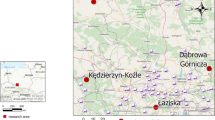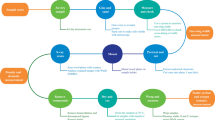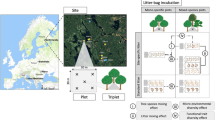Abstract
The goal was to find out how consistent the elemental distributions in tree rings are. The dataset was received for a long-term afforestation experiment that included even soil conditions and a variety of conifers (Scots pine, Norway spruce, Siberian pine, and Siberian larch) growing in pure stands. The stands are a part of a long-term experiment of the Institute of Forest SB RAS. The experiment is located in the vicinity of Krasnoyarsk city. Relative contents of elements (counts) were received through the scanning facility of Itrax Multiscanner (COX Analytical Systems). Every element was attributed with two variables: concentration of counts and quantity of counts. A cluster analysis was performed in a four-dimensional space of standard deviations and linear slopes of the variables. The elements studied non-randomly distribute over the clusters. Three elements (Ca, Co, and P) display a high consistency of distribution parameters in tree rings as they cluster largely irrespective of species. A few elements (Mn, Pb, Cl, Cr, Ni, Sr, and W) cluster consistently within species. Therefore, for the first time, it was found that the species factor does not affect the distribution of some elements, but significantly affects the distribution of others.
Similar content being viewed by others
REFERENCES
C. F. Baes and S. B. McLaughlin, Science 224, 494–497 (1984).
A. F. Chetverikov, in Dendrochronology and Dendroclimatology (Nauka, Novosibirsk, 1986), pp. 126–130 [in Russian].
E. A. Bondietti, C. F. Baes III, and S. B. McLaughlin, Can. J. Forest Res. 19, 586–594 (1989).
R. M. Khantemirov, Probl. Ekol. Monit. Model. Ekosist. 16, 153 (1996) [in Russian].
T. Prohaska, C. Stadlbauer, R. Wimmer, G. Stingeder, C. Latkoczy, E. Hoffmann, and H. Stephanowitz, Sci. Total Environ. 219, 29–39 (1998).
Y. Liu, W. Ta, T. Bao, Z. Yang, H. Song, N. Liu, W. Wang, H. Zhang, W. Zhang, and Z. An, Sci. China Ser. D 52, 504–510 (2009).
E. Selin, P. Standzenieks, J. Boman, and V. Teeyasoontranont, X-Ray Spectrom. 22, 281–285 (1993).
Yu. P. Demakov, S. M. Shvetsov, V. I. Talantsev, and K. K. Kalinin, Vestn. Povolzh. Gos. Tekhnol. Univ. Ser.: Les. Ekol. Prirodopol’zovanie, No. 3, 25–35 (2011) [in Russian].
I. F. Medvedev, S. S. Derevyagin, M. A. Kozachenko, and N. N. Gusakova, Agrar. Nauchn. Zh., No. 3, 12–14 (2015) [in Russian].
K. L. Padilla and K. A. Anderson, Chemosphere 49, 575–585 (2002).
E. L. Goldberg, K. B. Zolotarev, V. V. Maksimovskaya, V. I. Kondratyev, D. V. Ovchinnikov, and M. M. Naurzbaev, Nucl. Instrum. Methods Phys. Res., Sect. A 575, 196–198 (2007).
E. A. Vaganov, A. M. Grachev, V. V. Shishov, I. P. Panyushkina, S. W. Leavitt, A. A. Knorre, E. P. Chebykin, and O. V. Menyailo, Dokl. Biol. Sci. 453, 375 (2013).
I. P. Panyushkina, V. V. Shishov, A. M. Grachev, A. A. Knorre, A. V. Kirdyanov, S. W. Leavitt, E. A. Vaganov, E. P. Chebykin, E. A. Zhuchenko, and M. K. Hughe, Tree-Ring Res. 72, 67–77 (2016).
O. V. Menyailo, B. A. Hungate, and W. Zech, Plant Soil 242, 171–182 (2002).
L. S. Schugalei, in Tree Species Effects on Soils: Implications for Global Change, Ed. by D. Binkley and O. Menyailo (Springer, Dordrecht, 2005), pp. 257‒268.
ACKNOWLEDGMENTS
This research was funded by Russian Foundation for Basic Research, Government of Krasnoyarsk Territory, Krasnoyarsk Regional Fund of Science, to the research project: “Prognosis of region-specific responses of Siberian mountain forests to global environmental changes and of the landscape development trajectories for mitigation of environmental risks and an effective long-term planning in various economic sectors,” grant no. 18-45-240001, and by Russian Foundation for Basic Research to the research project: “Lateholocene dynamics of Asia boreal forests at the background of changing geochemistry and climatic conditions,” grant no. 19-05-00091.
Author information
Authors and Affiliations
Corresponding author
Rights and permissions
About this article
Cite this article
Gavrikov, V.L., Fertikov, A.I., Sharafutdinov, R.A. et al. Species-specific and Non-species-specific Elemental Trends in Tree Rings. Dokl. Earth Sc. 496, 96–99 (2021). https://doi.org/10.1134/S1028334X21010086
Received:
Revised:
Accepted:
Published:
Issue Date:
DOI: https://doi.org/10.1134/S1028334X21010086




